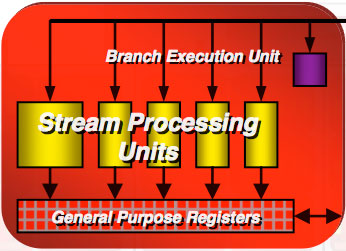ATI Radeon HD 2900 XT: Calling a Spade a Spade
by Derek Wilson on May 14, 2007 12:04 PM EST- Posted in
- GPUs
Different Types of Stream Processors
The first thing we need to do when looking at the R600 shader core is to define our terms. AMD and NVIDIA build and refer to their Stream Processors (SPs) differently, and that makes counting them a little more difficult. Throughout our explanation, it will help to remember from our G80 coverage that threads refer to a vertex, primitive or pixel and not a stream of instructions as it would on a CPU.
Stream Processors: The NVIDIA Way
G80 has 128 SPs (for the 8800 GTX; there are 96 SPs on the 8800 GTS models) that are capable of doing a very small number of things at the same time. They can do either standard FP operations (like a MADD), a special function operation (like sine), or an integer operation. There are some cases where they can squeeze out an extra MUL, but more often than not this MUL isn't accessible. Each of these SPs operates on an individual thread (be it a vertex, primitive or pixel).
This gives us a total of up to 128 threads being processed per clock. It is important to realize that each of the 128 SPs isn't entirely independent. That is, we can't run 128 different instructions in one clock, in spite of the fact that we can run a number of instructions on 128 different threads. We'll delve a little deeper into this shortly, but depending on the type of shader running, the same instruction must be running on multiple threads.
For NVIDIA hardware, the minimum number of threads that must be processed using the same instruction is 16 (for vertex threads). NVIDIA's block diagrams show that each group of 16 SPs shares texture, register, and cache resources, so this makes sense. Pixel shaders, which are more important from a performance perspective, must run one instruction on 32 pixels at a time. What we can extrapolate from this is that NVIDIA can issue up to eight separate instructions across all of its 128 SPs (only four if working on pixels) per clock.
128 SPs / 16 Threads per Instruction per Clock = 8 Vertex Instructions per Clock
128 SPs / 32 Threads per Instruction per Clock = 4 Pixel Instructions per Clock
Stream Processors: AMD's R600
Things are a little different on R600. AMD tells us that there are 320 SPs, but these aren't directly comparable to G80's 128. First of all, most of the SPs are simpler and aren't capable of special function operations. For every block of five SPs, only one can handle either a special function operation or a regular floating point operation. The special function SP is also the only one able to handle integer multiply, while other SPs can perform simpler integer operations.
This isn't a huge deal because straight floating point MAD and MUL performance is by far the limiting factors in shader performance today. The big difference comes in the fact that AMD only executes one thread (vertex, primitive or pixel) across a group of five SPs.

What this means is that each of the five SPs in a block must run instructions from one thread. While AMD can run up to five scalar instructions from that thread in parallel, these instructions must be completely independent from one another. This can place a heavy burden on AMD's compiler to extract parallel operations from shader code. While AMD has gone to great lengths to make sure every block of five SPs is always busy, it's much harder to ensure that every SP within each block is always busy.

If we take a step back, we can determine how many threads AMD is able to work on per clock. With 320 total SPs, each grouped into blocks of five-to-a-thread, we get 64 threads per clock. And here's where it starts to get complicated. Before we go back and compare this to NVIDIA's architecture, let's go a little deeper into the implementation.










86 Comments
View All Comments
imaheadcase - Tuesday, May 15, 2007 - link
Says who? Most people I know don't care to turn on AA since they visually can't see a difference. Only people who are picky about everything they see do normally, the majority of people don't notice "jaggies" since the brain fixes it for you when you play.
Roy2001 - Tuesday, May 15, 2007 - link
Says who? Most people I know don't care to turn on AA since they visually can't see a difference.------------------------------------------
Wow, I never turn it of once I am used to have AA. I cannot play games anymore without AA.
Amuro - Tuesday, May 15, 2007 - link
Says who? No one spent $400 on a video card would turn off AA.
SiliconDoc - Wednesday, July 8, 2009 - link
Boy we'd sure love to hear those red fans claiming they turn off AA nowadays and it doesn't matter.LOL
It's just amazing how thick it gets.
imaheadcase - Tuesday, May 15, 2007 - link
Sure they do, because its a small "tweak" with a performance hit. I say who spends $400 on a video card to remove "jaggies" when they are not noticeable in the first place to most people. Same reason most people don't go for SLI or Crossfire, because it really in the end offers nothing substantial for most people who play games.
Some might like it, but they would not miss it if they stopped using it for some time. Its not like its make or break feature of a video card.
motiv8 - Tuesday, May 15, 2007 - link
Depends on the game or player tbh.I play within ladders without AA turned on, but for games like oblivion I would use AA. Depends on your needs at the time.